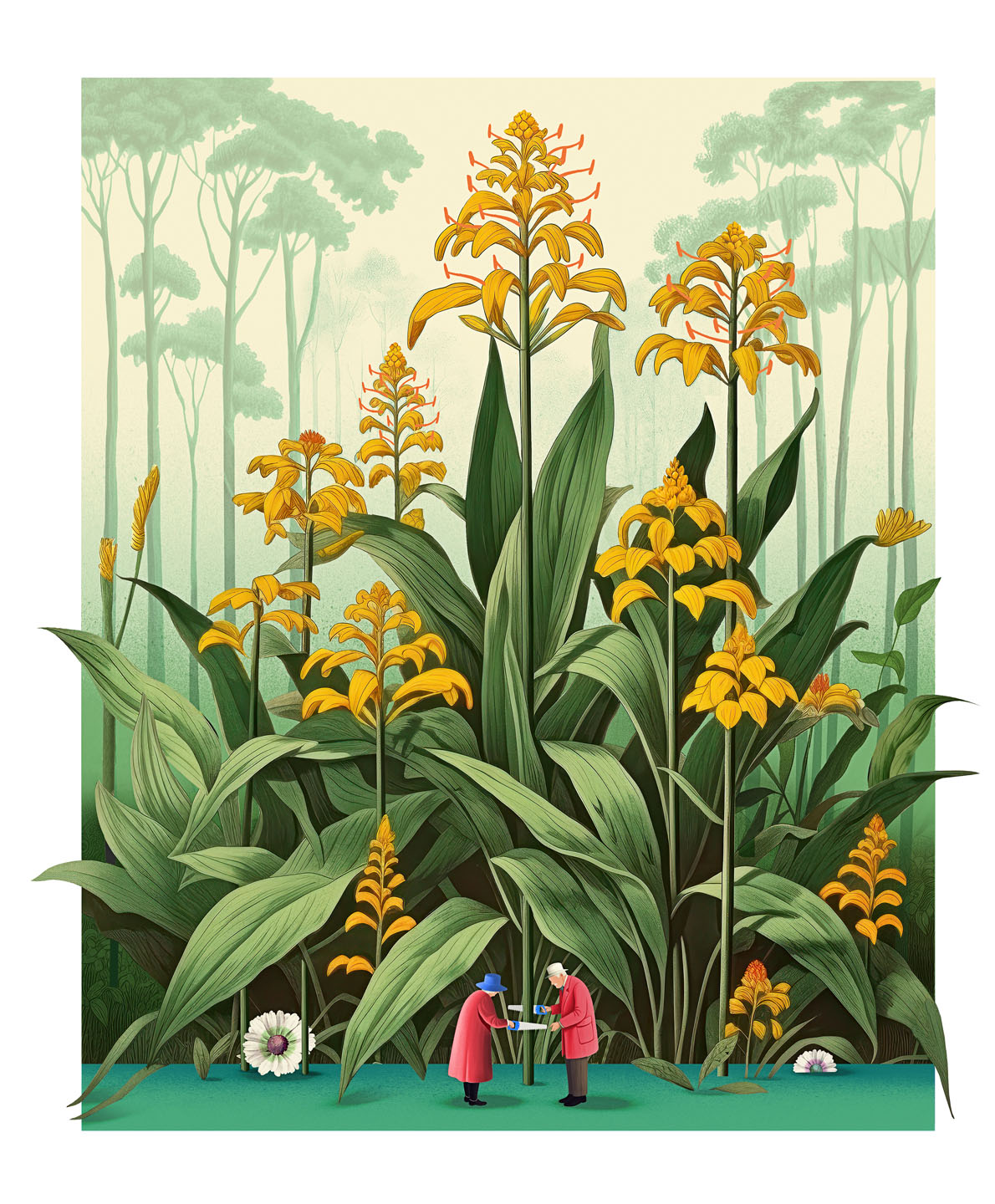When wildfires tore through Maui in August 2023, officials immediately identified the main causes: ongoing drought coupled with high winds that downed powerlines. Elsewhere, attention has landed on the exacerbating factor of non-native grasses. Introduced mainly by European and American ranchers who moved to the islands and needed livestock feed, these invasive grasses have spread over the last two centuries and now cover almost a quarter of Hawai‘i. They grow quickly and burn easily, making them perfect wildfire fuel.
My own trip to Hawaiʻi takes place a few months before the wildfires, and I’m visiting a different island. Invasive plants are my focus, though—at least for one morning of volunteering. Few sunseekers think to pitch in and help their hosts, but volunteering holidays don’t always require a long commitment. A few spare hours might be enough.
I’m earning my pool time today by helping Stewardship at the Summit, an organization dedicated to purging Hawai‘i Volcanoes National Park of invasive Himalayan ginger. Also known as kahili ginger, Hedychium gardnerianum is a devious interloper: a pretty partygoer slowly killing every other guest at the party. Unrelated to edible ginger root, the fast-growing perennial can reach two metres tall, and its dramatic foliage blocks sunlight from reaching native plants on the forest floor.
“Somebody who worked in the park in 1946 thought, what a great plant,” says Paul Field, a retired history professor. “It’s beautiful. It’s got a great fragrance.” It also has a spot on the International Union for Conservation of Nature’s list of 100 of the world’s worst invasive alien species. Paul and his wife, Jane, helm Stewardship at the Summit, fighting this tenacious species with little more than loppers, herbicide, and some impressive tenacity of their own. That, along with willing volunteers.
Once a week, volunteers spend a morning chopping down ginger. The following day, the Fields return and treat each cut stalk with herbicide. “We use a very bright blue dye so we can tell where we’ve been,” Paul says. “Jane and I, we do a lot of laundry.” Without herbicide, the ginger quickly grows back—a horror-movie villain that refuses to stay dead.
“If this isn’t done, the natural world around us will disappear, as it will wherever you are on the planet right now.”
As I hike deeper into the rainforest, loppers in hand, I fret about how to differentiate ginger from endemic plants. But my fear is baseless: Himalayan ginger’s dense rhizome beds are easy to distinguish from native greenery. The loppers make a satisfying chonk sound each time I cut through an inch-thick stalk, and the plant carcasses quickly pile up around me.
“It seems suspiciously easy,” one volunteer says.
“It is easy, and by the way, it’s also addictive,” Paul responds. He should know. He and Jane have been engaged in this battle since shortly after moving to the Island of Hawai‘i 11 years ago. They began volunteering at Kīlauea Visitor Center in the park, but Jane was eager to shift their work outdoors and fight the ginger. Eventually, the National Park Service granted them permission to revive the moribund Stewardship at the Summit program.
“If this isn’t done, the natural world around us will disappear,” Jane says, “as it will wherever you are on the planet right now.”
At 80 and 77, respectively, Jane and Paul know they can’t remain hands-on indefinitely. They hope a long-term volunteer will take over. Jessica Ferracane, a representative of Hawai‘i Volcanoes National Park, vows the program will continue. She’s grateful for all the unpaid labour so far. “We don’t have the funding or the staffing,” she says. “Volunteers really help us fulfill our mission.”
The park’s sheer size compounds the problem. “This park is more than 355,000 acres,” Ferracane says. “It ranges from sea level to the summit of Mauna Loa.”
“The native seed bank is still down there.”
The mammoth task of attacking so much ginger—about 15,000 acres of it in the park, Jane says—could depress anyone, but the Fields focus on their achievements. Paul gestures to the native holly and indigenous trees surrounding us. “Within two months of cutting the ginger out, we had hundreds of little seedlings coming up,” he says. “The native seed bank is still down there.” Pa‘iniu (a perennial herb), hāpuʻu (Hawaiian tree fern), and kōlea lau nui (a tree used for woodcraft) are returning, along with the bird species that rely on them.
“We can’t put a price on that kind of dedication,” Ferracane says. “What they’re doing is helping not just protect the rainforest in the park, but really, they’re helping convey a message of conservation and the importance of native species to visitors that come from all around the world.”
In the early days after COVID-19 travel restrictions eased, Hawaiʻi launched Mālama Hawaiʻi. This voluntourism initiative encourages visitors to deepen their connection to the islands and leave behind a smaller footprint. The website lists organizations looking for volunteers to do everything from cleaning up beaches to helping out at a cat sanctuary.
With Stewardship at the Summit, volunteers work alongside eco-minded locals, and results are evident at the end of each three-hour outing. After I finish my morning of chopping and stacking—tired and sunburnt, clothes filthy, sneakers caked with dirt—the forest’s newly cleared area fills me with pride.
My group spends the afternoon exploring more of the park, hiking across Kīlauea Iki Crater, then through Nāhuku (Thurston Lava Tube). Formed 500 years ago by lava hotter than 1,000 degrees Celsius, the cave would have taken a year to cool.
As we make our way around the park, I keep spotting Himalayan ginger and wishing I still had loppers on me. The addiction, it seems, is real.
Read more from our Winter 2023 issue.









